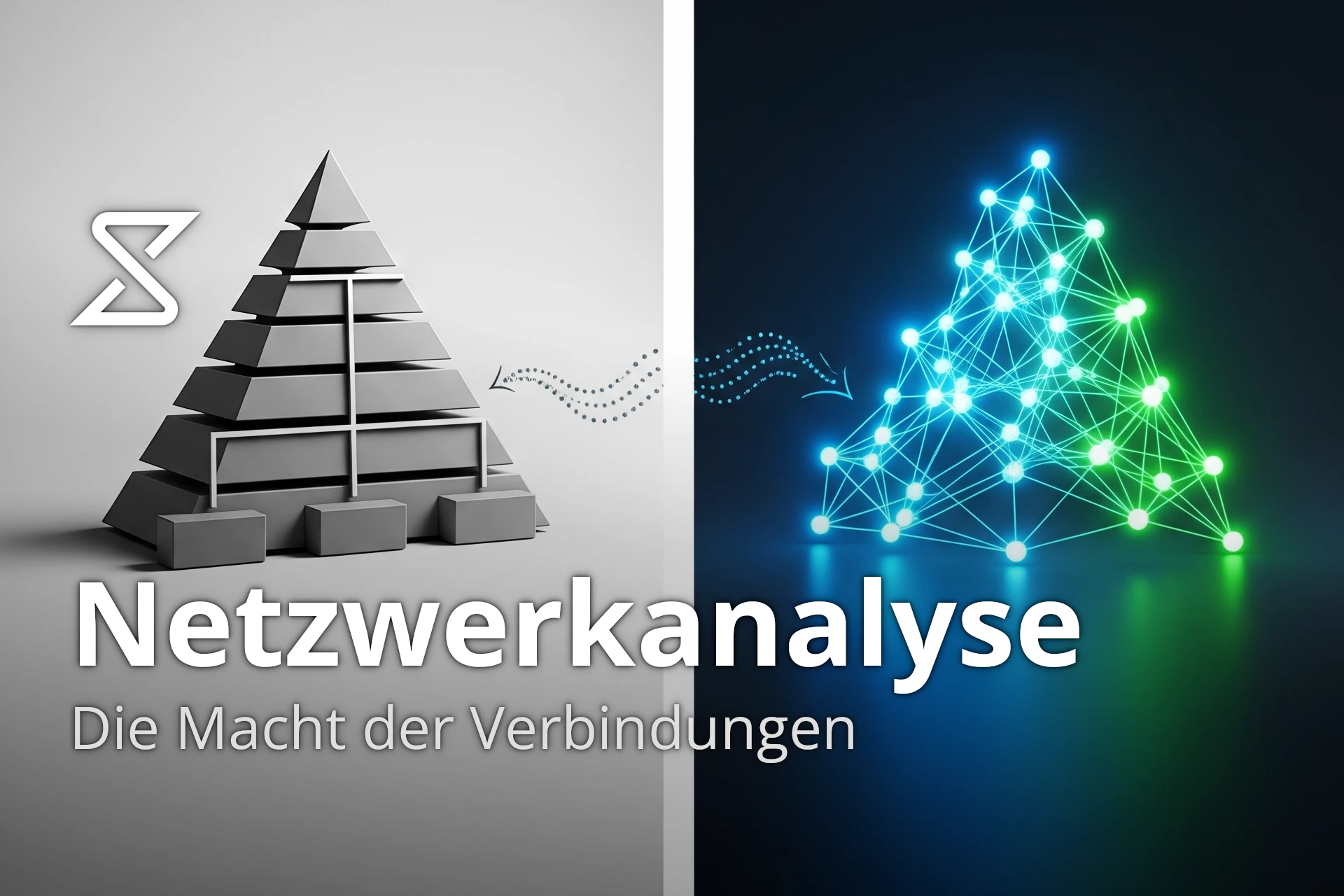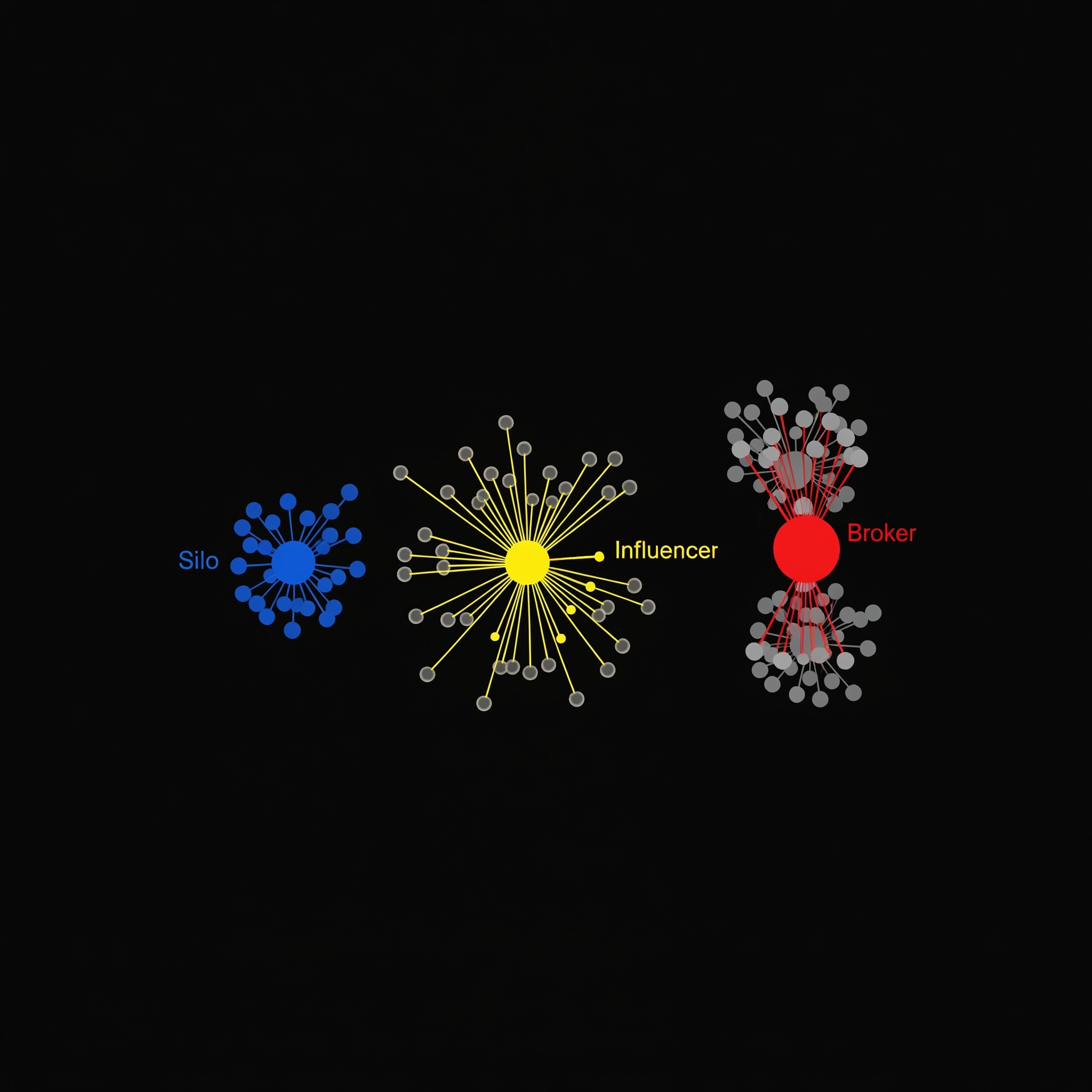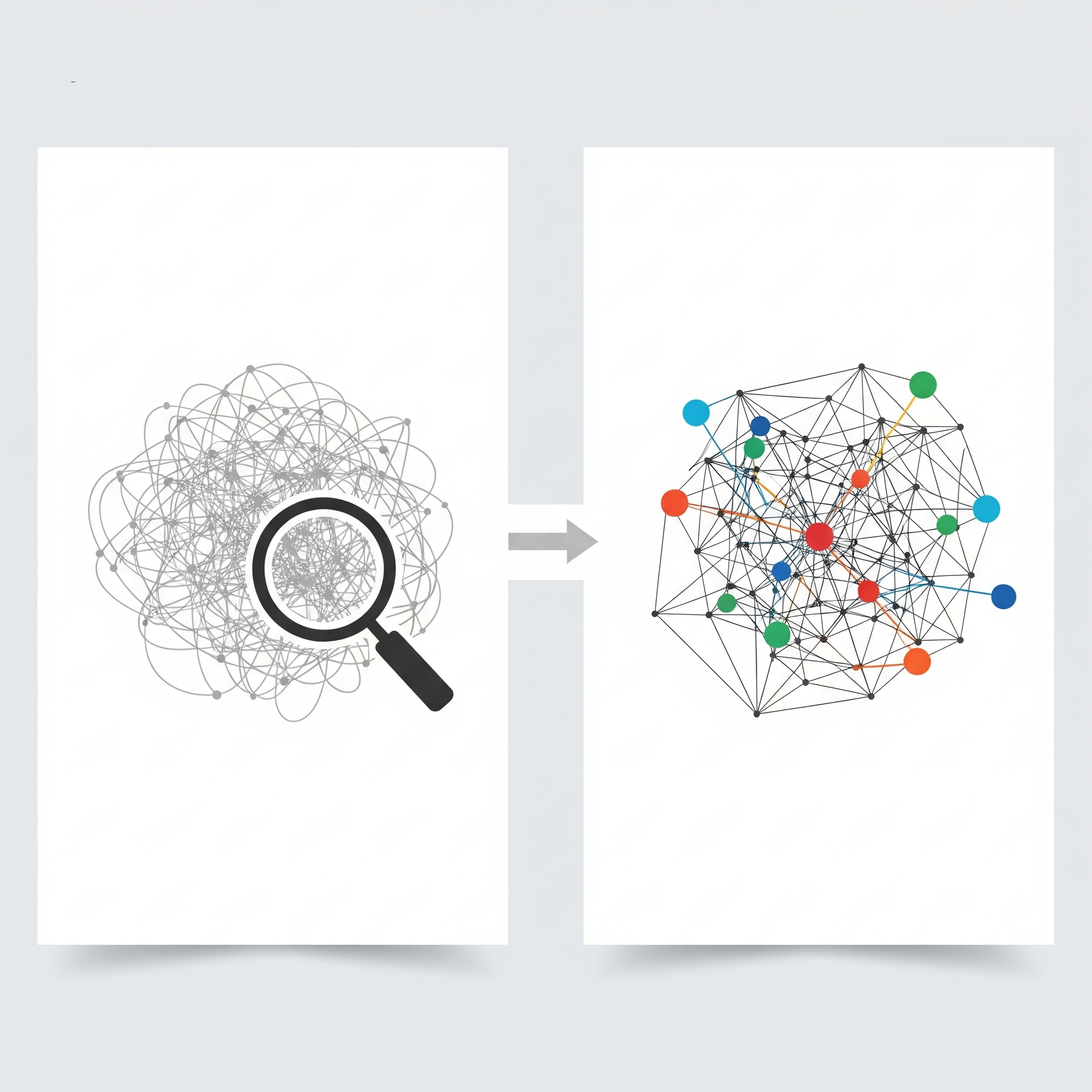Beyond Silos: Network Analysis in the Age of Agility & New Work
Have you ever wondered why brilliant ideas in your company sometimes simply fizzle out? Why collaboration falters despite agile methods? Or why a small disruption in the supply chain suddenly has catastrophic consequences? The answer often lies not in the individual departments, employees, or suppliers – but in the invisible connections between them.

The Power of Connections - Navigating the Complexity of the Modern Business World
For years, we have been taught to view our companies as pyramids: clear hierarchies, neat departments. Yet, reality is far more complex and dynamic. Companies are not rigid organizational charts. They are increasingly complex, living organisms. Companies are permeated by a dense web of relationships – internally between employees, teams, and departments, as well as externally with customers, suppliers, partners, and the entire market ecosystem. Traditional management approaches and rigid organizational charts are reaching their limits when it comes to understanding and effectively steering these multifaceted interactions. Superficial observations are no longer sufficient to grasp the dynamics and hidden forces that determine success or failure.
The digital transformation is fundamentally changing how companies operate, communicate, and create value by integrating new technologies and data streams. Simultaneously, globalization leads to sprawling, often fragile supply chains that span continents and are exposed to new risks. The market demands ever-increasing agility and adaptability, challenging traditional hierarchies and necessitating more flexible, networked organizational forms. Added to this are new work models like remote and hybrid work, which offer flexibility but also create new challenges for collaboration, communication, and corporate culture. These trends do not act in isolation; they reinforce each other and increase the dependency on functioning networks.
In this highly dynamic environment, network analysis offers a scientifically sound and data-driven solution. It is a powerful instrument for making the hidden structures and dynamics of relationships visible, analyzing them, and optimizing them in a targeted manner. Network analysis provides the necessary insights to master complexity, proactively manage risks, and find untapped potential. It is the strategic compass that helps companies not only to navigate the networked economy but also to actively shape it and achieve sustainable competitive advantages.
What is Network Analysis? Your X-Ray Vision for the Organization
Before exploring the diverse use cases, a fundamental understanding of network analysis is essential. At its core, it is a central methodological tool of complexity science, an interdisciplinary field dedicated to the systematic study of networks—their structure, dynamics, and properties. A network consists of two basic elements: nodes and edges. Nodes represent the actors in the network, such as individual employees, teams, departments, entire organizations, suppliers, or customers. Edges symbolize the connections or relationships between these nodes, such as communication flows, project collaboration, friendships, information exchange, payments, or goods deliveries.
The true power of the analysis, however, unfolds through the lens of complexity science. This teaches us that the behavior of the entire system—be it a company’s innovative capacity or the stability of a supply chain—is not simply the sum of its parts. Rather, the interplay of nodes and edges gives rise to unpredictable, emergent properties. Network analysis makes these very system dynamics—such as bottlenecks, cascade effects, or the spontaneous formation of opinion leaders—measurable and thus manageable.
Network analysis is more than just creating visually appealing network diagrams. It employs robust mathematical and statistical methods to precisely quantify the properties of the network and the positions of individual actors. This allows for the objective identification of:
- Key Players: Who are the central figures in the network? This includes not only formally high-ranking individuals but also:
- Connectors/Brokers (High Betweenness Centrality): Individuals who link different, otherwise unconnected parts of the network, thus playing a crucial role in the flow of information. They often control access to knowledge and resources.
- Experts/Influencers (High Degree or Eigenvector Centrality): Individuals who have many connections or are sought out by many others for advice. They are often opinion leaders or subject matter experts.
- Efficient Communicators (High Closeness Centrality): Individuals who can spread information particularly quickly through the network because they have, on average, the shortest paths to all others.
- Hidden Patterns and Structures: Where do isolated groups or departments (silos) exist? Where are the bottlenecks in the information flow? Which teams or individuals are working together unexpectedly closely (clusters, cliques)? Where are there structural holes whose bridging could foster innovation?
- Optimization Potential: Based on the analysis, targeted measures can be derived: How can knowledge flow be improved? Where does collaboration need to be strengthened? What interventions are necessary to break down silos or mitigate risks from isolated key individuals?

The dynamic perspective is also crucial. Network analysis does not just look at a snapshot of the structure; it can also analyze the dynamics of relationships and flows. How does knowledge or a new idea spread through the company? How do trust relationships develop over time? How do collaboration patterns change after a reorganization? This dynamic view enables a deeper understanding of organizational processes and the evaluation of the effectiveness of interventions.
Why Network Analysis is Crucial RIGHT NOW
The relevance of network analysis is rapidly increasing, driven by fundamental megatrends that are making our business world more connected and complex. Digitalization is creating intricate IT ecosystems and data flows, while globalized supply chains often harbor opaque and fragile dependencies. At the same time, the shift towards agile structures and hybrid work models demands a new understanding of collaboration, as formal hierarchies are replaced by dynamic, informal communication channels. These developments mean that traditional, linear perspectives are no longer sufficient to grasp the actual operational realities and risks.
This is where network analysis comes in, by making invisible connections visible. It uncovers critical vulnerabilities in supply chains, identifies communication bottlenecks in agile teams, and can reveal tendencies towards isolation among remote employees. Its true strength, however, lies in its synergy: it enables an integrated view across technology, human collaboration, and external partner relationships. In doing so, it provides the holistic perspective that is essential for making sound strategic decisions to proactively manage risks and unlock hidden potential in a complex environment.
Overview: Application Areas and Benefits of Network Analysis
The following table provides a structured overview of the central fields of application. It serves as a guide before the individual use cases are examined in detail, showing at a glance which typical problems are addressed and which core benefits can be realized in various business areas.
| Application Area (Use Case) | Typical Business Problem | How Network Analysis Helps (Briefly) | Key Benefits |
|---|---|---|---|
| Organizational Network Analysis (ONA) | Silos, inefficient collaboration, unclear information channels, talent gaps | Analysis of internal communication & collaboration patterns | Breaking down silos, increasing efficiency, identifying key players, talent development, change support |
| Supply Chain Network Analysis (SCNA) | Lack of transparency, high risks, low resilience, compliance pressure | Analysis & modeling of supply chain structure & flows | Creating transparency, managing risks, increasing resilience, boosting efficiency, ensuring compliance |
| CRM & Marketing | Low customer loyalty, ineffective marketing, unclear customer value | Analysis of customer interactions, relationships & value (CLV) | Maximizing CLV, strengthening customer loyalty, optimizing marketing, reducing churn, leveraging network effects |
| Knowledge Management (SNA) | Knowledge silos, slow knowledge transfer, inhibited innovation | Analysis of informal knowledge networks & expert roles | Finding experts & brokers, promoting knowledge transfer, accelerating innovation, preventing knowledge loss |
| Fraud Detection & Compliance | Complex fraud patterns, compliance violations | Analysis of transaction & relationship networks | Uncovering fraud rings, detecting anomalies, minimizing risks, improving compliance |
This overview illustrates the enormous breadth of network analysis. It is not a niche tool, but a strategic instrument with transformative potential for nearly all core areas of a company.
Perhaps the most profound advantage, however, is the cultivation of a “network thinking” mindset throughout the entire organization. When leaders and employees begin to think in terms of relationships, dependencies, and flows across departmental boundaries and hierarchical levels, it fundamentally changes the way problems are analyzed and solved. It promotes a more holistic perspective and a more collaborative culture. This ability to think and act systemically and in a networked way is a crucial core competency and a sustainable competitive advantage in today’s complex and dynamic business world. Network analysis is not just a tool, but also a catalyst for this important mental shift.
From Data to Real Value
Network visualizations are often impressive, yet their true value lies not in the image itself, but in the answers it can provide to strategic questions. However, the path from a complex graphic to an effective business measure is multifaceted. It begins with fundamental decisions: Which data source is appropriate, and how is a ‘connection’ defined in a way that fits the business context? The validity of the entire analysis is determined right here.
In the further course, it is a matter of drawing the right conclusions from the wealth of metrics. A high centrality of a node in the network can be a strength, but also a critical risk – the interpretation is rarely straightforward and requires a deep understanding of the methodology as well as the specific company context. However, the most meaningful insight remains ineffective if it is not translated into a tailored and actionable strategy. This final, crucial step requires the ability to link the analysis results with the company’s goals while also mastering sensitive aspects such as data protection and internal communication to enable sustainable change.

From Theory to Practical Implementation: Let’s Start a Conversation.
Network analysis opens up fascinating possibilities to make hidden structures in your company visible – and to actively shape them. Perhaps you are now wondering how these approaches can be specifically implemented in your context and what potential they hold for your unique challenges.
The path from idea to implementation is always individual. That is why we cordially invite you to a non-binding exchange with the experts at Solon Labs. In this initial conversation, we will take the time to understand your situation, clarify your questions, and discover potential together.
Our goal: To offer you a new, data-driven perspective on your processes – clear, understandable, and practical. If we have sparked your curiosity, we look forward to hearing from you.
Contact us to arrange an initial introductory meeting – completely non-binding and free of charge.